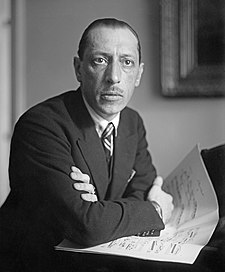|
| Project 366 continues in 2017-18 with "Time capsules through the Musical Eras - A Continued journey through the Western Classical Music Repertoire". Read more here. |
This is the
final set of time capsules in this tranche of Project 366 – these remaining seven listener guides are dedicated
to the music of Igor Stravinsky, in
my mond one of the most prolific and influential composers of the 20th
Century.
Igor Stravinsky (1882-1971)
Stravinsky’s
career arc mirrors the changing times in the 20th Century and in his
native Russia – at one point, he lived in Russia, Switzerland France and
America. The aesthetics and traditions reflected in his music are manty; from
post-Romantic in the Russian tradition, to neo-classical, to atonal.
Russian
period (c. 1907–1919)
Stravinsky
began piano lessons as a young boy, studying music theory and attempting
composition. At his parents’ urging, he entered law school in Saint-Petersburg,
but after four years of study, he chose to take private lessons under the
tutelage of Nikolai Rimsky-Korsakov, with whom he studied from 1905 until
Rimsky's death in 1908.
Listener Guide #
238 – Symphonic Stravinsky
Stravinsky’s
“Opus One” is a Symphony in E♭ major. Of classical 4-movement
structure, it is broadly influenced by Rimsky-Korsakov, Glazunov, Tchaikovsky
and Wagner. The score bears the dedication "To my dear teacher N. A.
Rimsky-Korsakov". (ITYWLTMT
Montage # 263 – 31 October 2017)
Listener Guide # 239
– Ballet Suites
In 1909,
Stravinskly began a long association with ballet impresario Serge Diaghilev for
which he composed several ballets, including his first major effort in the
genre, The Firebird first performed
at the Paris Opéra on 25 June 1910. (ITYWLTMT
Montage # 278 – 4 May 2018)
Listener Guide # 240
– Petrouchka
Stravinsky's
second ballet for the Ballet Russes, Petrouchka,
is where "Stravinsky at last became Stravinsky." The music itself
makes significant use of a number of Russian folk tunes in addition to two
waltzes by Viennese composer Joseph Lanner and a French music hall tune (La Jambe
en bois or The Wooden Leg).(Vinyl’s
Revenge # 25 – 28 February 2018)
Neoclassical
period (c. 1920–1954)
During this
period, most of the aesthetics of Stravinsky’s compositions embrace a return to
the music of the Classical period but also his exploration of themes from the
ancient Classical world, such as Greek mythology.
Listener Guide # 241
– Symphony of Psalms
Unlike many
pieces composed for chorus and orchestra, Stravinsky said that “it is not a
symphony in which I have included Psalms to be sung. On the contrary, it is the
singing of the Psalms that I am symphonizing.” The work was commissioned by
Serge Koussevitzky to celebrate the 50th anniversary of the Boston Symphony
Orchestra. (Vinyl’s
Revenge # 34 – 23 January 2018)
Listener Guide # 242
– Basel and Dumbarton Oaks
This
all-Stravinsky time capsule features two
of his concertos for orchestra and his set of neo-baroque danses concertantes. (Vinyl’s
Revenge # 22 – 1 November 2016)
Listener Guide # 243
– Ernest Ansermet
With his
passion for precision, Ansermet became, over time, one of the composer's most
trusted interpreters, giving the premières of the Capriccio for piano and
orchestra (1929, with Stravinsky at the keyboard). This artistic relationship
would founder on the composer's late-career embrace of atonality, a system
which Ansermet, trained as a mathematician, would reject on scientific as well
as aesthetic grounds. (ITYWLTMT
Montage # 286 – 31 July 2018)
Serial
period (1954–1968)
In the
1950s, Stravinsky began using serial compositional techniques such as the
twelve-tone technique originally devised by Arnold Schoenberg. He first
experimented with non-twelve-tone serial techniques in small-scale vocal and
chamber works.
Listener Guide # 244
– Intimate Works
This final
time capsule of “intimate” works by Stravinsky spans many decades, and features
most notably tracks from a pair of recordings by members of the Orpheus Chamber
Ensemble. (ITYWLTMT
Montage # 283 – 29 June 2018)


:format(jpeg):mode_rgb():quality(90)/discogs-images/R-4405076-1364026784-6091.jpeg.jpg)
:format(jpeg):mode_rgb():quality(90)/discogs-images/R-9404265-1479982777-9784.jpeg.jpg)
:format(jpeg):mode_rgb():quality(90)/discogs-images/R-8205763-1461867411-4817.jpeg.jpg)
No comments:
Post a Comment